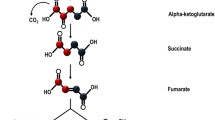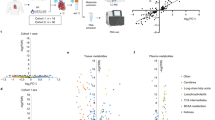Abstract
The objective of the present study was to compare energy substrate fluxes through metabolic pathways leading to mitochondrial citrate synthesis and release in normal and diseased rat hearts using 13C-substrates and mass isotopomer analysis by gas chromatography-mass spectrometry (GCMS). This study was prompted by our previous finding of a modulated citrate release by perfused rat hearts and by the possibility that a dysregulated myocardial citrate release represents a specific chronic alteration of energy metabolism in cardiac patients. The 15-week-old spontaneously hypertensive rat (SHR) was chosen as our animal model of disease and the Wistar-Kyoto (WKY) rat as its matched control. Ex vivo work-performing hearts were perfused with a semi-recirculating buffer containing physiological concentrations of unlabeled (glucose) and 13C-labeled ([U-13C3](lactate + pyruvate) and/or [1-13C]oleate) substrates. In parallel to the continuous monitoring of indices of the heart's functional and physiological status, the following metabolic parameters were documented: (i) citrate release rates and citric acid cycle intermediate tissue levels, (ii) the contribution of fatty acids as well as pyruvate decarboxylation and carboxylation to citrate synthesis, and (iii) lactate and pyruvate uptake and efflux rates. Working hearts from both rat species showed a similar percent contribution of carbohydrates for citrate synthesis through decarboxylation (70%) and carboxylation (10%). SHR hearts showed the following metabolic alterations: a higher citrate release rate, which was associated with a parallel increase in its tissue level, a lower contribution of oleate β-oxidation to citrate synthesis, and an accelerated efflux rate of unlabeled lactate from glycolysis. These metabolic changes were not explained by differences in myocardial oxygen consumption, cardiac performance or efficiency, nor correlated with indices of tissue necrosis or ischemia. This study demonstrates how the alliance between ex vivo semi-recirculating working perfused rat hearts with 13C-substrates and mass isotopomer analysis by GCMS, can provide an unprecedented insight into the metabolic phenotype of normal and diseased rat hearts. The clinical relevance of metabolic alterations herein documented in the SHR heart is suggested by its resemblance to those reported in cardiac patients. Taken altogether, our results raise the possibility that the increased citrate release of diseased hearts results from an imbalance between citrate synthesis and utilization rates, which becomes more apparent under conditions of substrate abundance.
Similar content being viewed by others
References
Thomassen AR, Nielsen TT, Bagger JP, Henningsen P: Myocardial exchanges of glutamate, alanine and citrate in controls and patients with coronary artery disease. Clin Sci 64: 33-40, 1983
Thuesen L, Nielsen TT, Thomassen A, Bagger JP, Henningsen P: Beneficial effect of a low-fat low-calorie diet on myocardial energy metabolism in patients with angina pectoris. Lancet 2: 59-62, 1984
Thomassen AR, Nielsen TT, Bagger JP, Henningsen P: Cardiac metabolic and hemodynamic effects of insulin in patients with coronary artery disease. Diabetes 38: 1175-1180, 1989
Opie LH: Cardiac metabolism—emergence, decline, and resurgence. Part I. Cardiovasc Res 26: 721-733, 1992
Stanley WC, Lopaschuk GD, Hall JL, McCormack JG: Regulation of myocardial carbohydrate metabolism under normal and ischemic conditions. Potential for pharmacological interventions. Cardiovasc Res 33: 243-257, 1997
Taegtmeyer H, Goodwin GW, Doenst T, Frazier OH: Substrate metabolism as a determinant for postischemic functional recovery of the heart. Am J Cardiol 80: 3A-10A, 1997
Lopaschuk GD, Rebeyka IM, Allard MF: Metabolic modulation: A means to mend a broken heart. Circulation 105: 140-142, 2002
Barr RL, Lopaschuk GD: Methodology for measuring in vitro/ex vivo cardiac energy metabolism. J Pharmacol Toxicol Meth 43: 141-152, 2000
Comte B, Vincent G, Bouchard B, Des Rosiers C: Probing the origin of acetyl-CoA and oxaloacetate entering the citric acid cycle from the 13C labeling of citrate released by perfused rat heart. J Biol Chem 272: 26117-26124, 1997
Comte B, Vincent G, Bouchard B, Des Rosiers C: A 13C mass isotopomer study of anaplerotic pyruvate carboxylation in perfused rat hearts. J Biol Chem 272: 26125-26131, 1997
Laplante A, Vincent G, Poirier M, Des Rosiers C: Effects and metabolism of fumarate in the perfused rat heart. A 13C mass isotopomer study. Am J Physiol 272: E74-E82, 1997
Vincent G, Comte B, Poirier M, Bouchard B, Des Rosiers C: Citrate release by perfused rat hearts: A window on mitochondrial cataplerosis. Am J Physiol 278: E846-E856, 2000
Panchal AR, Comte B, Huang H, Kerwin T, Darvish A, Des Rosiers C, Brunengraber H, Stanley WC: Partitioning of pyruvate between oxidation and anaplerosis in swine hearts. Am J Physiol 279: H2390-H2398, 2000
Panchal AR, Comte B, Huang H, Dudar B, Roth B, Chandler M, Des Rosiers C, Brunengraber H, Stanley WC: Acute hibernation decreases myocardial pyruvate carboxylation and citrate release. Am J Physiol 281: H1613-H1620, 2001
Depré C, Rider MH, Hue L: Mechanisms of control of heart glycolysis. Eur J Biochem 258: 277-290, 1998
Ruderman NB, Saha AK, Vavvas D, Witters LE: Malonyl-CoA, fuel sensing, and insulin resistance. Am J Physiol 276: E1-E18, 1999
Cheema-Dhadli S, Robinson BH, Halperin ML: Properties of the citrate transporter in rat heart: Implications for regulation of glycolysis by cytosolic citrate. Can J Biochem 54: 561-565, 1976
Sluse FE, Meijer AJ, Tager JM: Anion translocators in rat-heart mitochondria. FEBS Lett 18: 149-153, 1971
Kinney Lapier TL, Rodnick KJ: Changes in cardiac energy metabolism during early development of female SHR. Am J Hypertens 13: 1074-1081, 2000
Haneda T, Ichihara K, Abiko Y, Onodera S: Functional and metabolic responses to ischemia in the perfused heart isolated from normotensive and spontaneously hypertensive rats. Jpn Circ J 50: 607-613, 1986
Barger PM, Kelly DP: Fatty acid utilization in the hypertrophied and failing heart: Molecular regulatory mechanisms. Am J Med Sci 318: 36-42, 1999
Allard MF, Schönekess BO, Henning SL, English DR, Lopaschuk GD: Contribution of oxidative metabolism and glycolysis to ATP production in hypertrophied hearts. Am J Physiol 267: H742-H750, 1994
Christe ME, Rodgers RL: Altered glucose and fatty acid oxidation in hearts of the spontaneously hypertensive rat. J Mol Cell Cardiol 26: 1371-1375, 1994
Doenst T, Goodwin GW, Cedars AM, Wang M, Stepkowski S, Taegtmeyer H: Load-induced changes in vivo alter substrate fluxes and insulin responsiveness of rat heart in vitro. Metabolism 50: 1083-1090, 2001
Hajri T, Ibrahimi A, Coburn CT, Knapp FF Jr, Kurtz T, Pravenec M, Abumrad NA: Defective fatty acid uptake in the spontaneously hypertensive rat is a primary determinant of altered glucose metabolism, hyperinsulinemia, and myocardial hypertrophy. J Biol Chem 276: 23661-23666, 2001
Seymour A-M L, Chatham JC: The effects of hypertrophy and diabetes on cardiac pyruvate dehydrogenase activity. J Mol Cell Cardiol 29: 2771-2778, 1997
Chatham JC, Des Rosiers C, Forder JR: Evidence of separate pathways for lactate uptake and release by the perfused rat heart. Am J Physiol 281: E794-E802, 2001
Gamcsik MP, Forder JR, Millis KK, McGovern KA: A versatile oxygenator and perfusion system for magnetic resonance studies. Biotech Bioeng 49: 348-354, 1996
Rodgers RL, Christe ME, Tremblay GC, Babson JR, Daniels T: Insulin-like effects of a physiologic concentration of carnitine on cardiac metabolism. Mol Cell Biochem 226: 97-105, 2001
Bergmeyer HU: In: Methods of Enzymatic Analysis, vol. 3, 2nd edn. Verlag Chemie International, Academic Press, New York, 1974
Starnes JW, Wilson DF, Erecinska M: Substrate dependence of metabolic state and coronary flow in perfused rat heart. Am J Physiol 249: H799-806, 1985
Bünger R, Mallet RT, Hartman DA: Pyruvate-enhanced phosphorylation potential and inotropism in normoxic and postischemic isolated working heart. Near-complete prevention of reperfusion contractile failure. Eur J Biochem 180: 221-233, 1989
Goodwin GW, Cohen DM, Taegtmeyer H: [5-3H]glucose overestimates glycolytic flux in isolated working rat heart: Role of pentose phosphate pathway. Am J Physiol 280: E502-E508, 2001
Gibala MJ, Young ME, Taegtmeyer H: Anaplerosis of the citric acid cycle: Role in energy metabolism of heart and skeletal muscle. Acta Physiol Scand 168: 657-665, 2000
Brooks GA: Intra-and extra-cellular lactate shuttles. Med Sci Sports Exerc 32: 790-799, 2000
Weiss JN, Venkatesh N: Metabolic regulation of cardiac ATP-sensitive K+ channels. Cardiovasc Drugs Ther 7: 499-505, 1993
Gardner PR, Fridovich I: Superoxide sensitivity of the Escherichi coli aconitase. J Biol Chem 266: 19328-19333, 1991
Janero DR, Hreniuk D: Suppression of TCA cycle activity in the cardiac muscle cell by hydroperoxide-induced oxidant stress. Am J Physiol 270: C1735-C1742, 1996
Nulton-Persson AC, Szweda LI: Modulation of mitochondrial function by hydrogen peroxide. J Biol Chem 276: 23357-23361, 2001
Dhalla AK, Hill MF, Singal PK: Role of oxidative stress in transition of hypertrophy to heart failure. J Am Coll Cardiol 28: 506-514, 1996
Rupp H, Schulze W, Vetter R: Dietary medium-chain triglycerides can prevent changes in myosin and SR due to CPT-1 inhibition by etomoxir. Am J Physiol 269: R630-R640, 1995
Boomsma F, van den Meiracker AH: Plasma A-and B-type natriuretic peptides: Physiology, methodology and clinical use. Cardiovasc Res 51: 442-449, 2001
H'Doubler PB Jr, Petersen M, Shek W, Auchincloss H, Abbott WM, Orkin RW: Spontaneously hypertensive and Wistar-Kyoto rats are genetically disparate. Lab Anim Sci 41: 471-473, 1991
Kurtz TW, Morris RC Jr: Biological variability in Wistar-Kyoto rats. Hypertension 10: 127-131, 1987
Belke DD, Larsen TS, Lopaschuk, GD, Severson DL: Glucose and fatty acid metabolism in the isolated working mouse heart. Am J Physiol 277: R1210-R1217, 1999
Author information
Authors and Affiliations
Rights and permissions
About this article
Cite this article
Vincent, G., Khairallah, M., Bouchard, B. et al. Metabolic phenotyping of the diseased rat heart using 13C-substrates and ex vivo perfusion in the working mode. Mol Cell Biochem 242, 89–99 (2003). https://doi.org/10.1023/A:1021189728877
Issue Date:
DOI: https://doi.org/10.1023/A:1021189728877




